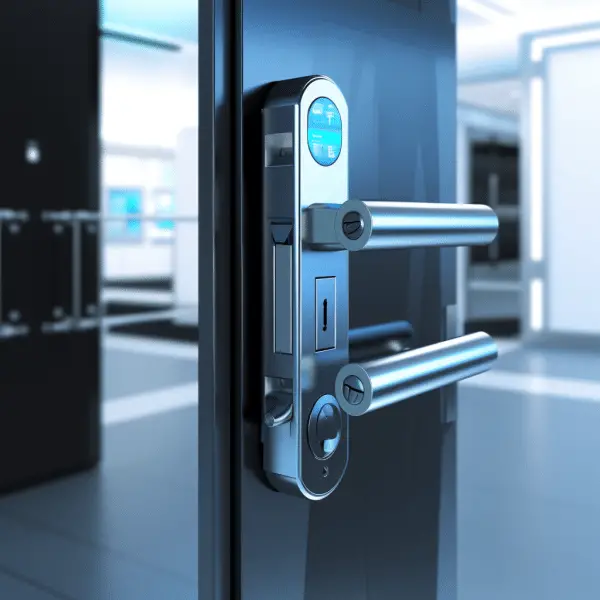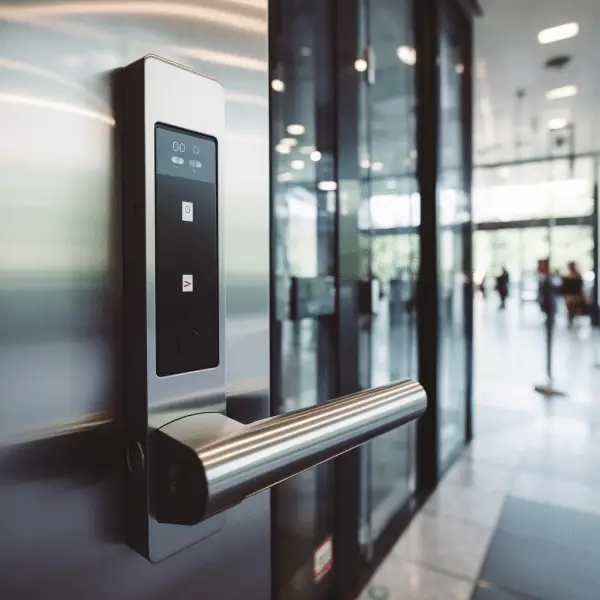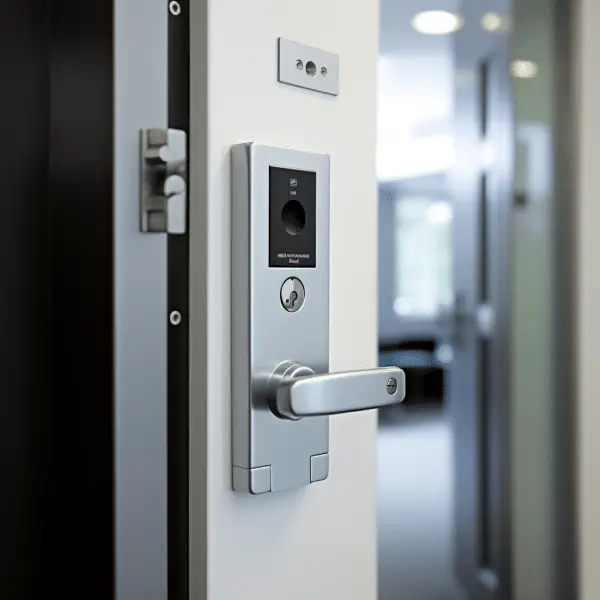Welcome to my beginner’s guide to magnetic locks. In this article, we will delve into the world of magnetic locks and explore their significance in the realm of access control. Whether you’re new to the concept or looking to deepen your understanding, this guide will provide you with the essential knowledge to make informed decisions regarding magnetic locks for your facility.
Access control systems play a crucial role in maintaining security and controlling entry to various premises. Magnetic locks have gained popularity due to their effectiveness and ease of use. By utilizing the power of electromagnetism, these locks provide a secure means of restricting access to authorized personnel while offering flexibility in terms of installation and compatibility with access control systems.
Throughout this guide, we will cover the fundamental aspects of magnetic locks, from their working principles and advantages, to considerations for installation, integration with access control systems, and maintenance. By the end, you will have a comprehensive understanding of magnetic locks and be equipped to navigate the world of access control with confidence.
Key Takeaways:
- Magnetic locks provide a high level of security and ease of use in access control systems.
- They operate based on electromagnetism, utilizing an electromagnet and an armature plate to secure doors.
- Magnetic locks offer advantages such as durability, versatility, and resistance to picking or hacking.
- Considerations for installation include power supply, integration with access control systems, and compliance with fire safety regulations.
- Regular maintenance and troubleshooting are essential for ensuring the proper functioning of magnetic locks.
Understanding Magnetic Locks
Access control systems using magnetic locks are popular due to their security and convenience of use. We must study electromagnetism to comprehend magnetic locks. An electromagnet on the door frame and an armature plate on the door make up these locks.
The electromagnet’s enormous magnetic force holds the armature plate securely, preventing the door from opening while the magnetic lock is engaged. A magnetic field is created by electrical current flowing in the electromagnet’s coiled wire.
Turning off the electromagnet releases the magnetic force, allowing the armature plate to disengage and open the door. This technology makes magnetic locks secure and reliable access control.

Advantages of Magnetic Locks
Magnetic locks offer several advantages over traditional locks. One of the key benefits is their high level of security. Unlike traditional locks that can be susceptible to picking or hacking, magnetic locks are more difficult to bypass due to the strength of the magnetic force holding the door in place.
Another advantage is the durability of magnetic locks. They are built to withstand wear and tear, making them a long-lasting option for access control systems. This durability ensures that magnetic locks can withstand the daily operation and heavy usage often encountered in commercial and industrial settings.
Furthermore, magnetic locks are versatile and can be installed on various types of doors, including glass, metal, and wood. This versatility makes them suitable for a wide range of applications, from office buildings to retail stores to residential complexes.
Considerations for Installation
When installing magnetic locks, there are a few important factors to consider. First and foremost, a reliable power supply is essential to ensure consistent operation of the locks. Magnetic locks can be powered by either AC or DC power, with DC power being the most common option.
Integrating magnetic locks with an access control system is another crucial consideration. This allows for centralized management and monitoring of access permissions, enhancing security and convenience. It is important to ensure compatibility between the magnetic locks and the chosen access control system.
Lastly, compliance with fire safety regulations is imperative. Magnetic locks should be able to release in the event of a fire or emergency to ensure a safe exit. It is essential to follow fire safety guidelines and ensure that the magnetic locks meet the necessary requirements for emergency situations.
| Advantages of Magnetic Locks | Considerations for Installation |
|---|---|
| High level of security | Reliable power supply |
| Durable and resistant to wear and tear | Integration with access control system |
| Versatile for different door types | Compliance with fire safety regulations |
By understanding how magnetic locks work and considering the advantages they offer as well as the necessary installation considerations, you can make informed decisions when implementing an access control system for your facility.
Advantages of Magnetic Locks
Magnetic locks offer several advantages that make them a popular choice for access control systems. Their high level of security, durability, and versatility make them a reliable option for various applications.
Security
Magnetic locks provide enhanced security compared to traditional locks. The electromagnet creates a strong magnetic force that securely holds the door in place, making it difficult to pick or hack. This ensures that unauthorized individuals cannot bypass the lock, maximizing the security of your facility.
Durability
Magnetic locks are designed to withstand wear and tear, making them a durable option for long-term use. They are resistant to external factors such as humidity, temperature changes, and physical impact, ensuring their reliable performance over time. With minimal maintenance, magnetic locks can continue to provide effective security for extended periods.
Versatility
One of the key advantages of magnetic locks is their versatility. They can be installed on various door types, including glass, metal, and wood, making them suitable for different environments. Whether you need access control for an office building, retail store, or apartment complex, magnetic locks can accommodate your specific requirements.
Magnetic locks offer a high level of security, durability, and versatility for access control systems.
Considerations for Installation
When it comes to installing magnetic locks, there are several important factors to consider. These considerations will ensure that your access control system functions reliably and complies with necessary regulations. The key considerations for installation include power supply, integration with an access control system, and adherence to fire safety regulations.
Power Supply
The power supply is a critical aspect of magnetic lock installation. It is essential to have a reliable power source to ensure continuous operation of the locks. Magnetic locks can be powered by either AC or DC power, with DC being the more common option. When choosing a power supply, make sure it provides sufficient voltage and amperage to meet the requirements of your magnetic locks.
Integration with Access Control System
Integrating magnetic locks with an access control system allows for centralized management and monitoring of access. This integration enables you to control who can enter and exit your facility, track door activity, and easily revoke access if needed. When installing magnetic locks, ensure compatibility with your chosen access control system and follow the manufacturer’s guidelines for integration.
Fire Safety Regulations
Fire safety regulations are of utmost importance when installing magnetic locks. In the event of a fire or emergency, it is crucial for the locks to release and allow for a swift evacuation. Ensure that your magnetic locks are installed in compliance with local fire safety regulations and that they are connected to the appropriate fire alarm system. This will ensure the safety of your occupants while maintaining the security of your facility.
| Considerations for Installation | Key Points |
|---|---|
| Power Supply | Choose a reliable power source that provides sufficient voltage and amperage for your magnetic locks. |
| Integration with Access Control System | Ensure compatibility between your magnetic locks and your chosen access control system for centralized management and monitoring. |
| Fire Safety Regulations | Follow local fire safety regulations to ensure that your magnetic locks release during emergencies while maintaining security. |
By considering these factors during the installation process, you can ensure the proper functioning and compliance of your magnetic locks. Consult with professionals in the field for expert advice and to ensure that your installation meets all necessary requirements.
Maintenance and Troubleshooting
Regular maintenance is crucial for ensuring the proper functioning of magnetic locks. By implementing a routine maintenance schedule, you can prevent potential issues and extend the lifespan of your locks. Here are some key maintenance tasks to keep in mind:
- Clean the lock and armature plate: Dust, dirt, and debris can accumulate over time and affect the lock’s performance. Regularly clean the lock and armature plate with a soft cloth and mild cleaning solution.
- Check for loose connections: Ensure that all wiring connections are secure and tight. Loose connections can lead to electrical problems and cause the lock to malfunction.
- Lubricate moving parts: Apply a small amount of lubricant to any moving parts or hinges to reduce friction and ensure smooth operation. Be sure to use a lubricant that is compatible with the lock’s materials.
- Test the lock: Regularly test the lock to ensure it is functioning correctly. Use a key or access card/fob to open and close the door, verifying that the lock engages and disengages properly.
Troubleshooting tips for solving these issues
Despite regular maintenance, it’s possible to encounter common issues with magnetic locks. Here are some troubleshooting tips for solving these issues:
- Misalignment: If the lock and armature plate are not properly aligned, the lock may not engage or disengage correctly. Adjust the alignment by loosening the mounting screws and repositioning the lock or plate as needed.
- Faulty wiring: Check the wiring connections to ensure they are secure and properly connected. Replace any damaged or frayed wires that could be causing electrical issues.
- Power supply problems: If the lock is not receiving power, check the power supply and ensure it is functioning correctly. Test the lock with a different power source to determine if the issue is with the power supply.
- Remember: If you are unsure or unable to resolve an issue with your magnetic lock, it is recommended to consult a professional locksmith or access control technician for assistance.
By regularly maintaining and troubleshooting your magnetic locks, you can ensure their reliability and effectiveness in providing secure access control for your facility.
| Common Issues | Troubleshooting |
|---|---|
| Misalignment | Adjust the lock and armature plate alignment |
| Faulty wiring | Check and replace damaged or frayed wires |
| Power supply problems | Check the power supply and test with a different source |
Integration with Access Control Systems
Integrating magnetic locks with access control systems offers a seamless and robust solution for enhancing security and convenience. By combining the strengths of magnetic locks with various access control technologies, you can create a comprehensive access management system tailored to your specific needs.
Card Readers
Card readers for magnetic lock access control are widespread. Users can enter with proximity cards or key fobs. The access control system triggers the magnetic lock to unlock the door after the card reader signals it. Card readers provide easy deactivation of lost or stolen cards to prevent unlawful entrance.
Biometric Systems
Biometric systems offer an even higher level of security and authentication by using unique physiological or behavioral traits. By integrating biometric systems such as fingerprint or facial recognition with magnetic locks, you can further enhance access control. These systems provide a highly accurate and tamper-proof method of identification, significantly reducing the risk of unauthorized access.
Integration with access control systems enables centralized management of access permissions and monitoring of door activity. It allows administrators to easily grant or revoke access, track entry and exit times, and generate detailed access logs. By harnessing the power of access control integration, you can create a comprehensive security solution that meets your specific requirements.
| Access Control Integration Benefits | |
|---|---|
| Centralized management of access permissions | Efficiently control who has access to various areas |
| Monitoring of door activity | Track entry and exit times for improved security |
| Convenient access methods | Enable users to gain access using proximity cards or biometrics |
| Enhanced security | Reduce the risk of unauthorized entry with advanced authentication methods |
Choosing the Right Magnetic Locks
When selecting magnetic locks for your access control system, it is crucial to consider several factors to ensure compatibility and reliability. The lock specifications play a vital role in determining the lock’s suitability for your specific application. Key specifications to consider include the holding force, voltage, and dimensions.
Firstly, the holding force of the magnetic lock should be appropriate for the type of door you are securing. Different doors may require different holding forces to ensure optimal security. Additionally, the voltage of the lock should align with your power supply capabilities to guarantee consistent performance.
Moreover, it is essential to consider the dimensions of the magnetic lock to ensure it can be effectively installed on your door. Accurate measurements and proper installation are crucial for the lock to function as intended and provide the desired level of security.
When selecting a magnetic lock, it is also important to consider the vendor’s reputation. Look for reputable vendors who offer high-quality products and reliable customer support. This ensures that you receive a reliable and durable magnetic lock that meets your security needs.
Table: Comparison of Lock Specifications
| Specification | Lock A | Lock B | Lock C |
|---|---|---|---|
| Holding Force (lbs) | 1200 | 800 | 1500 |
| Voltage (V) | 12 | 24 | 12 |
| Dimensions (inches) | 5 x 1.5 x 1 | 4 x 2 x 1 | 6 x 1.25 x 0.75 |
“Choosing the right magnetic lock is crucial for the overall effectiveness of your access control system. Consider the lock specifications, ensuring they align with your door type and security requirements. Additionally, research and select reputable vendors to ensure you receive a high-quality product with reliable customer support.”
By carefully considering lock specifications and vendor reputation, you can make an informed decision when choosing magnetic locks for your access control system. This thoughtful selection process will help ensure compatibility, reliability, and optimal security for your facility.

Conclusion
In conclusion, this beginner’s guide has provided an overview of magnetic locks for access control systems. By understanding the basics of how magnetic locks work and their advantages, you can make informed decisions when it comes to implementing security measures for your facility.
It is important to consider factors such as power supply, integration with access control systems, and compliance with fire safety regulations for successful installation. Regular maintenance and troubleshooting are also crucial to ensure the proper functioning of magnetic locks.
By choosing the right magnetic locks that suit your specific requirements and working with reputable vendors, you can enhance the security and convenience of your access control system. Remember to test and regularly maintain your magnetic locks to ensure optimal performance.
Key takeaways from this guide include understanding the principles of electromagnetism, the security advantages of magnetic locks, the importance of integration with access control systems, and the necessity of maintenance and troubleshooting. By following these guidelines, you can implement effective and reliable access control solutions for your facility.
FAQ
How do magnetic locks work?
Magnetic locks operate on the principle of electromagnetism. An electromagnet attached to the door frame creates a strong magnetic force that holds an armature plate on the door, preventing it from being opened. When the power to the electromagnet is turned off, the magnetic force is released, allowing the door to be opened.
What are the advantages of magnetic locks?
Magnetic locks provide a high level of security, are durable and resistant to wear and tear, and can be installed on various types of doors. They are also difficult to pick or hack compared to traditional locks.
What should be considered during magnetic lock installation?
Considerations include ensuring a reliable power supply, integrating with an access control system, and complying with fire safety regulations to ensure the lock can release in emergencies.
What maintenance is required for magnetic locks?
Regular maintenance involves cleaning the lock and armature plate, checking for loose connections, lubricating moving parts, and testing the lock to ensure proper functioning.
How can magnetic locks be integrated with access control systems?
Magnetic locks can be seamlessly integrated with access control systems, such as card reader systems or biometric systems, allowing for centralized management of access permissions and monitoring of door activity.
How should the right magnetic locks be chosen?
Consider the lock specifications suitable for your door type and security needs, ensure compatibility with your existing access control system, and choose magnetic locks from reputable vendors that offer quality products and reliable customer support.

